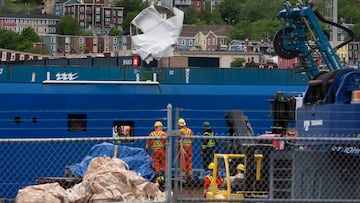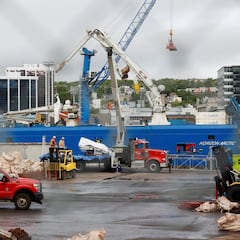New details emerge about discovery of Titan submersible debris
Ed Cassano, the head of the team whose ROV found the remains of the Titan submersible, held a press conference to explain the search process on Friday.

Four days after contact was lost with the Titan submersible, the US Coast Guard announced on Thursday 22 June that the vessel, which had set off on a dive towards the wreckage of the Titanic, was believed to have imploded, killing all five people on board.
A week after the loss of the Titan was confirmed, the first pieces of debris were brought ashore at Newfoundland, Canada, with the US Coast Guard revealing that “presumed human remains” have been discovered in the wreckage.
See also:
Rescue mission quickly became recovery - ROV team chief
In a press conference on Friday, Pelagic Research Services CEO Ed Cassano, the head of the search team whose remotely-operated vehicle (ROV) found the Titan debris, became visibly emotional as he recalled the moment that the remains of the submersible were discovered, some 1,500 feet from the Titanic. It quickly became clear that there would be no hope of finding survivors, he said.
Having arrived at the search area in the north Atlantic Ocean, around 400 miles off the coast of Newfoundland, Cassano’s team deployed its ROV, known as Odysseus 6K. The craft was lowered into the sea using a large ‘umbical cord’, and took around an hour and a half to reach the seafloor.
“Plain and simple, we were focused on rescue,” Cassano told reporters at Pelagic’s headquarters in East Aurora, New York. “[But] shortly after arriving on the seafloor, we discovered the debris of the Titan submersible.” A rescue mission quickly “turned into a recovery”, he said. “I have to apologise,” Cassano added as he choked back tears. “We’re still demobilising, it’s a lot of emotions.”
Ed Cassano, CEO of Pelagic Research Services, outlines the timeline for the Titan search, and describes how the team discovered debris from the submersible "shortly after arriving on the sea floor".
— Sky News (@SkyNews) June 30, 2023
Live: https://t.co/pEbyWAM5xL
📺 Sky 501, Virgin 602, Freeview 233 and YouTube pic.twitter.com/TM4K7oIlt0
Several ships, three planes, and underwater robots
Related stories
In total, 10 ships were involved in the search mission, supported by three C-130 planes from the US army, as the authorities combed an area of about 12,500 square miles. The US Coast Guard led the operation, while the Canadian army contributed sonobuoys - portable sonar systems that can detect underwater vessels. In the final stages of the search, the Victor 6000 underwater robot, supplied by the French government, was also used.
One of the ships that took part was Deep Energy, which normally lays deep-water pipes and cables. From the vessel, a submersible was deployed that was only able to dive to a depth of about 9,000 fee t; the remains of the Titan were sitting at around 12,500 feet underneath the surface of the Atlantic.
Video - Watch as Titan debris brought ashore at Newfoundland:



